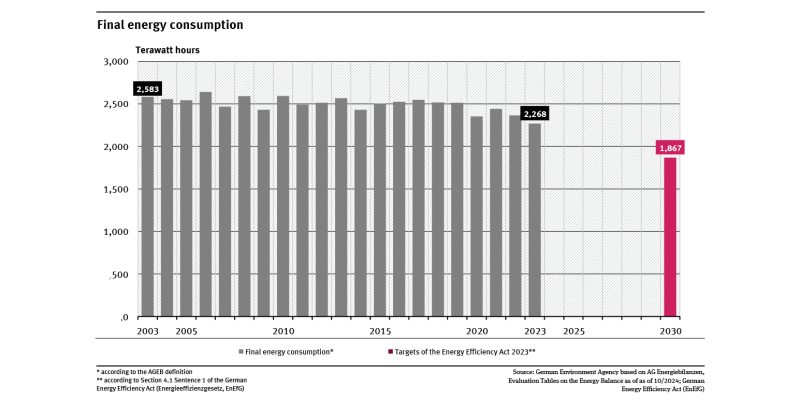Indicator: Final energy consumption
 Click to enlarge
Click to enlargeSource: German Environment Agency based on AG Energiebilanzen Figure as PDF
 Umweltbundesamt
Umweltbundesamt
 Click to enlarge
Click to enlarge
- The use of energy resources (energy consumption) is associated with many negative environmental impacts.
- The figure "final energy consumption" excludes the consumption of the energy system itself and reflects the energy consumption of end consumers.
- The Energy Efficiency Act sets the target that final energy consumption should be 1,867 Terawatt hours by 2030.
- The German Environment Agency's "Projection Report 2023" shows that the measures taken to date are unlikely to be sufficient to achieve these targets.
The term "final energy consumption" (FEC) refers to the amount of energy made available by the energy system to end consumers such as industry or private households. It does not take into account conversion and transmission losses in the energy system or non-energy consumption. The FEC therefore reflects the development of energy consumption by end users.
Energy consumption has many negative effects on the environment: Fossil fuels are often extracted with considerable environmental impact through mining. Their transportation leads to pollutant emissions and poses risks such as shipping and pipeline accidents. The conversion of energy sources in power plants or refineries is associated with the emission of large quantities of greenhouse gases and other pollutants. But renewable energies also have an impact on the environment and nature. For these reasons, energy and environmental policy strives to reduce (final) energy consumption. This also makes economic sense, as lower energy consumption also means lower energy costs.
Between 2008 and 2023, the FEC according to the definition of the Energy Efficiency Act (see next paragraph) fell by around 12.5 %, with a slight downward trend. It is important to note here: As the FEC is dominated by energy consumption for heating and cooling, weather conditions have a major influence on the development of consumption.
German legislators passed the "Energy Efficiency Act" (EnEfG) in the fall of 2023. The Act stipulates that FEC should fall to 1,867 TWh by 2030
The "Projection Report 2023 for Germany" (German, with English summary) examined whether Germany can achieve its energy and climate targets in 2030 on the basis of scenario analyses: If all the measures planned by the governing coalition are implemented, the FEC is expected to fall by around 16% in 2030 compared to 2008 ('with existing measures' scenario). This would fall well short of the EnEfG target for 2030. Further measures to reduce the FEC are therefore necessary in order to achieve the EnEfG targets.
Final energy consumption is regularly calculated by the Working Group on Energy Balances (AGEB). It is based on various energy statistics surveys and modeling. The AGEB publishes methodological information on the calculation in the “Explanatory notes on the energy balances” (in German only). In line with the EU Energy Efficiency Directive, the EnEfG uses a slightly different definition from AGEB.
More detailed information (in German only): ‘Energieverbrauch nach Energieträgern, Sektoren und Anwendungen‘.